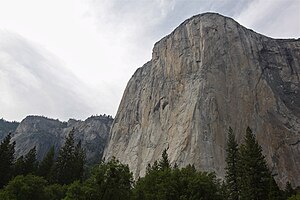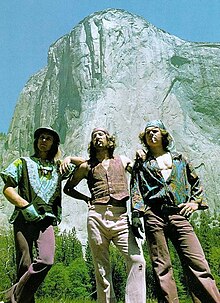
Hans Florine is an American rock climber, who holds the record for the number of ascents of Yosemite Valley's El Capitan and is known for holding the speed record on The Nose of Yosemite’s El Capitan 8 different times. Hans' last speed record on The Nose was accomplished with Alex Honnold for climbing The Nose in 2:23:46, on June 17, 2012. In addition to climbing El Capitan over 175 times, Hans also holds the record for the number of ascents of The Nose, climbing it more than 111 times.

Carolynn Marie Hill is an American rock climber. Widely regarded as one of the leading competitive climbers, traditional climbers, sport climbers, and boulderers in the world during the late 1980s and early 1990s, she is famous for making the first free ascent of the difficult sheer rock face of The Nose on El Capitan in Yosemite Valley, and for repeating it the next year in less than 24 hours. She has been described as both one of the best female climbers in the world and one of the best climbers in the history of the sport. One of the first successful women in the sport, Hill shaped rock climbing for women and became a public spokesperson, helping it gain wider popularity and arguing for sex equality. Hill has publicized climbing by appearing on television shows and documentaries and writing an autobiography, Climbing Free: My Life in the Vertical World.
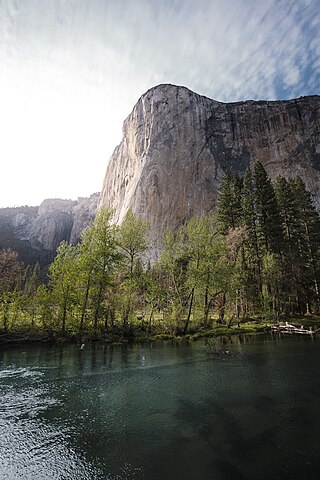
El Capitan is a vertical rock formation in Yosemite National Park, on the north side of Yosemite Valley, near its western end. The granite monolith is about 3,000 feet (914 m) from base to summit along its tallest face and is a world-famous location for big wall climbing, including the disciplines of aid climbing, free climbing, and more recently for free solo climbing.

Alexander Huber, is a German rock climber who is considered one of the greatest and most influential climbers in the history of rock climbing. Huber came to prominence in the early 1990s as the world's strongest sport climber after the passing of Wolfgang Güllich. He is the second-ever person to redpoint a 9a (5.14d) graded route by ascending Om in 1992, and has latterly come to be known as the first-ever person to redpoint a 9a+ (5.15a) graded route from his 1996 ascent of Open Air.
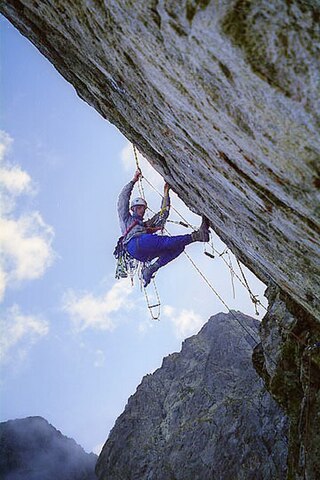
Aid climbing is a form of rock climbing that uses mechanical devices and equipment, such as aiders, for upward momentum. Aid climbing is the opposite of free climbing, which only uses mechanical equipment for protection, but not to assist in upward momentum. "Traditional aid climbing" involves hammering in permanently fixed pitons and bolts, into which aiders are clipped, whereas "clean aid climbing" avoids hammering, using only removable placements.
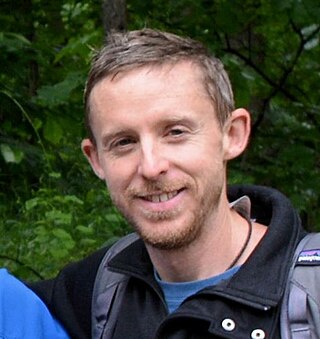
Tommy Caldwell is an American rock climber who has set records in sport climbing, traditional climbing, and in big-wall climbing. Caldwell made the first free ascents of several major routes on El Capitan in Yosemite National Park.

Royal Robbins was one of the pioneers of American rock climbing. After learning to climb at Tahquitz Rock, he went on to make first ascents of many big wall routes in Yosemite. As an early proponent of boltless, pitonless clean climbing, he, along with Yvon Chouinard, was instrumental in changing the climbing culture of the late 1960s and early 1970s by encouraging the use and preservation of the natural features of the rock. He went on to become a well-known kayaker.

Warren Harding was one of the most accomplished and influential American big wall climbers and aid climbers of the 1950s to 1970s. He was the leader of the first team to climb El Capitan, Yosemite Valley, in 1958. The route they climbed, known as The Nose, ascends 2,900 feet (880 m) up the central buttress of what is one of the largest granite monoliths in the world. Harding made many first ascents in Yosemite, some 28 in all, including The Wall of Early Morning Life.
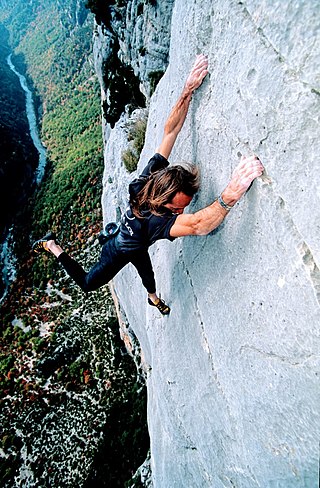
Free solo climbing, or free soloing, is a form of rock climbing where the climbers climb solo without ropes or other protective equipment, using only their climbing shoes and their climbing chalk. Free soloing is the most dangerous form of climbing, and, unlike bouldering, free soloists climb above safe heights, where a fall can be fatal. Though many climbers have free soloed climbing grades they are very comfortable on, only a tiny group free solo regularly, and at grades closer to the limit of their abilities.

The Regular Northwest Face of Half Dome was the first Grade VI big wall climbing route in the United States. It was first climbed in 1957 by a team consisting of Royal Robbins, Mike Sherrick, and Jerry Gallwas. Its current aid climbing rating is VI 5.9 A1 or 5.12 for the free climbing variation. It is recognized in the historic climbing text Fifty Classic Climbs of North America and considered a classic around the world.

In the history of rock climbing, the three main sub-disciplines—bouldering, single-pitch climbing, and big wall climbing—can trace their origins to late 19th-century Europe. Bouldering started in Fontainebleau, and was advanced by Pierre Allain in the 1930s, and John Gill in the 1950s. Big wall climbing started in the Dolomites, and was spread across the Alps in the 1930s by climbers such as Emilio Comici and Riccardo Cassin, and in the 1950s by Walter Bonatti, before reaching Yosemite where it was led in the 1950s to 1970s by climbers such as Royal Robbins. Single-pitch climbing started pre-1900 in both the Lake District and in Saxony, and by the late-1970s had spread widely with climbers such as Ron Fawcett (Britain), Bernd Arnold (Germany), Patrick Berhault (France), Ron Kauk and John Bachar (USA).
Beth Rodden is an American rock climber known for her ascents of hard single-pitch traditional climbing routes. She was the youngest woman to climb 5.14a (8b+) and is one of the only women in the world to have redpointed a 5.14c (8c+) traditional climbing graded climb. Rodden and fellow climber Tommy Caldwell were partners from 2000 to 2010, during which time they completed the second free ascent of The Nose. In 2008, Rodden made the first ascent of Meltdown, one of the hardest traditional climbs in the world and the first time in history that a female climber matched the peak of the highest climbing grades.
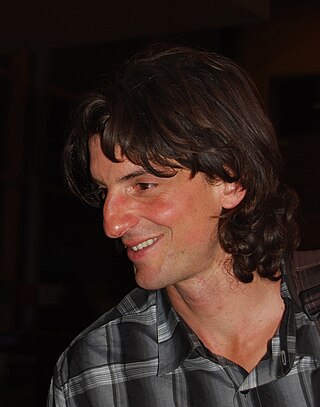
Dean Spaulding Potter was an American free climber, alpinist, BASE jumper, and highliner. He completed many hard first ascents, free solo ascents, speed ascents, and enchainments in Yosemite National Park and Patagonia. In 2015, he died in a wingsuit flying accident in Yosemite National Park.
El Capitan is a film by filmmaker Fred Padula that captures one of the earliest ascents of The Nose on El Capitan in Yosemite Valley, California. It has won several awards at film festivals around the world.

Big wall climbing is a form of rock climbing that takes place on long multi-pitch routes that normally require a full day, if not several days, to ascend. In addition, big wall routes are typically sustained and exposed, where the climbers remain suspended from the rock face, even sleeping hanging from the face, with limited options to sit down or escape unless they abseil back down the whole route. It is therefore a physically and mentally demanding form of climbing.

Alex Honnold is an American rock climber best known for his free solo ascents of big walls. Honnold rose to worldwide fame in June 2017 when he became the first person to free solo a route on El Capitan in Yosemite National Park, a climb described in The New York Times as "one of the great athletic feats of any kind, ever." Honnold also holds the record for the fastest ascent of the "Yosemite Triple Crown", an 18-hour, 50-minute link-up of Mount Watkins, The Nose, and the Regular Northwest Face of Half Dome. In 2015, he won a Piolet d'Or in alpine climbing with Tommy Caldwell for their completion of the enchainment of the Cerro Chaltén Group in Patagonia over 5 days.

Sender Films is an American film production company based in Boulder, Colorado. Productions include outdoor adventure films, television shows, and commercials.
Mayan Smith-Gobat is a professional big-wall climber from New Zealand and, as of 2019, held the record for fastest all-female team ascent of El Capitan's The Nose in Yosemite, California at four hours and forty three minutes. Smith-Gobat, along with climbing partner Libby Sauter, completed the climb in October, 2014. Other notable ascents include her 2012 first female ascent (FFA) of Punks in the Gym (5.14a) in the Arapiles climbing region of Australia, and the first all female Half Dome/El Cap link up in Yosemite in 2013.
Brad Gobright was an American rock climber known for free solo climbing.

Barbara "Babsi" Zangerl is an Austrian rock climber who is widely considered as one of the best all-round female climbers in the world. At various stages in her career, she has climbed at, or just below, the highest climbing grades achieved by a female in every major rock climbing discipline, including bouldering, traditional climbing, sport climbing, multi-pitch climbing and big wall climbing.
